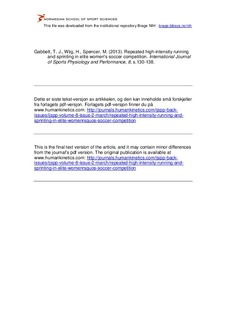| dc.contributor.author | Gabbett, Tim J. | |
| dc.contributor.author | Wiig, Håvard | |
| dc.contributor.author | Spencer, Matt | |
| dc.date.accessioned | 2014-09-26T12:32:59Z | |
| dc.date.available | 2014-09-26T12:32:59Z | |
| dc.date.issued | 2013 | |
| dc.identifier.citation | International Journal of Sports Physiology and Performance. 2013, 8, 130-138 | nb_NO |
| dc.identifier.uri | http://hdl.handle.net/11250/221814 | |
| dc.description | I Brage finner du siste tekst-versjon av artikkelen, og den kan inneholde ubetydelige forskjeller fra forlagets pdf-versjon. Forlagets pdf-versjon finner du på http://journals.humankinetics.com/ijspp-back-issues/ijspp-volume-8-issue-2-march / In Brage you'll find the final text version of the article, and it may contain insignificant differences from the journal's pdf version. The original publication is available at http://journals.humankinetics.com/ijspp-back-issues/ijspp-volume-8-issue-2-march | nb_NO |
| dc.description.abstract | Background: To the authors’ knowledge, no study has investigated the concurrent repeated, high-intensity (RHIA) and repeated-sprint activity (RSA) of intermittent team-sport competition. Purpose: In this study, they report on the RSA of elite women’s football competition. In addition, they describe the nature of RHIA (eg, striding and sprinting activities) that involve a high energy cost and are associated with short (ie, ≤20 s) recovery periods. Methods: Thirteen elite women soccer players underwent video-based time–motion analysis on 34 occasions during national and international standard matches. RSA and RHIA were defined as successive (ie, 2) sprints or striding and sprinting efforts that occurred with ≤20 s between efforts. Results: The number of RSA and RHIA bouts performed was similar between the first and second halves of matches. Sprinting and striding/sprinting durations tended to remain relatively stable irrespective of the number of efforts in an RSA or RHIA bout or the period of play. However, recovery duration between efforts increased in the second half, when a greater number of efforts were performed per bout. Conclusion: These findings suggest that first- to second-half reductions in RHIA and RSA do not occur in elite women’s soccer competition. However, players increase the amount of low-intensity recovery undertaken between RHIA and RSA efforts, most likely in an attempt to maintain RHIA and RSA performance. These findings emphasize the importance of RSA and RHIA to elite women’s soccer and highlight the importance of training this quality to prevent reductions in performance during competitive match play. | nb_NO |
| dc.language.iso | eng | nb_NO |
| dc.publisher | Human Kinetics | nb_NO |
| dc.subject | time-motion analysis | nb_NO |
| dc.subject | high-speed running | nb_NO |
| dc.subject | repeated-sprint ability | nb_NO |
| dc.subject | training | nb_NO |
| dc.subject | team sports | nb_NO |
| dc.title | Repeated high-intensity running and sprinting in elite women’s soccer competition | nb_NO |
| dc.type | Journal article | nb_NO |
| dc.type | Peer reviewed | nb_NO |
| dc.subject.nsi | VDP::Social science: 200::Social science in sports: 330::Other subjects within physical education: 339 | nb_NO |
| dc.source.journal | International Journal of Sports Physiology and Performance (IJSPP) | nb_NO |
| dc.description.localcode | Seksjon for fysisk prestasjonsevne / Department of Physical Performance | nb_NO |
